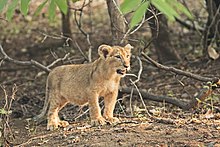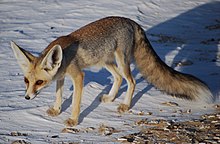Wildlife of Iraq
[4] Aquatic or semi-aquatic wildlife occurs in and around these lakes:[6][7][8] Water birds recorded in marshlands in southern Iraq include little grebe, great crested grebe, cormorant, darter, bittern, grey heron, night heron, purple heron, white stork, cattle egret, sacred ibis, Eurasian teal, common redshank, pied kingfisher, greater spotted eagle, marsh harrier, hooded crow, Iraq babbler, crested lark, pin-tailed sandgrouse, collared dove, Indian roller and starling.[9] Iraqi coastal waters boast a living coral reef, covering 28 km2 in the Persian Gulf, at the mouth of the Shatt al-Arab river (29°37′00″N 048°48′00″W / 29.61667°N 48.80000°W / 29.61667; -48.80000).[17] The Marbled polecat is a omnivorous weasel located in deserts of N.Iraq whose diet consists of small rodents, birds, lizards, fish, frogs, fruit, and grass.The Wild boar is a omnivorous swine located in the marshes and along the numerous rivers in Iraq whose diet consists of plants(rhizomes, roots, bulbs, tubers, nuts, berries, seeds, leaves, bark, twigs, shoots), earthworms, insectivores, insects, rodents, bird eggs, lizards, snakes, frogs, and carrion.[16] The Bactrian camel is located in varying habitats from rocky mountains to arid deserts and has a herbivorous diet that consists of various kinds of vegetation.





habitatsmarshlandsEuphrates riverdesertmammalspeciesnorthern bald ibisPersian fallow deerSyrian wild assSaudi Arabian dorcas gazelleMesopotamian MarshesmarshesflamingopelicanSiberiaAfricamarbled tealBasra reed-warblerIndian crested porcupinebandicoot ratgray wolfMulti-National ForceAkkadianLake HabbaniyahLake MilhLake QadisiyahLake Thartharlittle grebegreat crested grebecormorantdarterbitterngrey heronnight heronpurple heronwhite storkcattle egretsacred ibisEurasian tealcommon redshankpied kingfishergreater spotted eaglemarsh harrierhooded crowIraq babblercrested larkpin-tailed sandgrousecollared doveIndian rollerstarlingcoastal waterscoral reefPersian GulfShatt al-AraboctocoralsophiuroidsbivalvessilicademospongesAsiatic lionEurasian ottersmooth-coated otterPersian leopardsand catWildcatRüppell's foxMarbled polecatSmall Indian mongooseGoitered gazelleWild boarBactrian camelEuropean hareCaucasian squirrelBroad-toothed field mouseYellow-necked mouseHouse mouseBlack ratShort-tailed bandicoot ratIndian gerbilSundevall's jirdCaspian tigerAsiatic cheetahBasrahTigrisArabian oryxSyrian elephantsList of mammals of IraqWildlife of IranScientific ReportsBibcodeWildlife of Asia Sovereign statesAfghanistanArmeniaAzerbaijanBahrainBangladeshBhutanBruneiCambodiaCyprusGeorgiaIndonesiaIsraelJordanKazakhstanNorth KoreaSouth KoreaKuwaitLebanonMalaysiaMaldivesMongoliaMyanmarPakistanPhilippinesRussiaSaudi ArabiaSingaporeSri LankaTajikistanThailandTurkeyTurkmenistanUnited Arab EmiratesUzbekistan